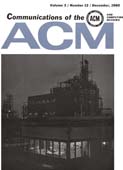December 1960 - Vol. 3 No. 12

Features
Survey of coded character representation
Technical Committee 97 of the International Standards Organization (ISO) is concerned with standards in data processing. The American Standards Association holds the secretariat of this committee. Sectional Committee X3 of A.S.A. is responsible for national data processing standards in the U. S.
The “Survey of Coded Character Representation” by R. W. Bemer (p. 639) covers the representation of symbols in paper tape, magnetic tape and main storage of a number of different machine systems. Another method of mechanical storage is the punched card. The results of a similar survey for punched card codes are shown in the table on page 642.
On programming the numerical solution of polynomial equations
Numerical techniques are presented for computing the roots of polynomial equations. By applying the recommended scaling and inversion rules, the basic Bistrow and Newton-Raphson iterative techniques can be applied with great reliability. Both a high degree of accuracy and rapid convergence are realized. Numerical examples are shown to illustrate the pitfalls and to show how these are circumvented by application of the recomended procedures.
In reference to the discussion about evaluation ex on page 500 of the September Communications of the ACM, may I point out that there is no need to use Mr. Berin's lengthy expressions to obtain relation (9). If we use the simple formula (5) for x/2 and divide by the same formula for - x/2, we get (9) immediately.
A method for overlapping and erasure of lists
An important property of the Newell Shaw-Simon scheme for computer storage of lists is that data having multiple occurrences need not be stored at more than one place in the computer. That is, lists may be “overlapped.” Unfortunately, overlapping poses a problem for subsequent erasure. Given a list that is no longer needed, it is desired to erase just those parts that do not overlap other lists. In LISP, McCarthy employs an elegant but inefficient solution to the problem. The present paper describes a general method which enables efficient erasure. The method employs interspersed reference counts to describe the extent of the overlapping.
Two methods for word inversion on the IBM 709: method 1
In some logical problems it is necessary or convenient to invert the bit structure of a word, i.e., replace bit i by bit n + 1 - i for i = 1, 2, ···, n, thus creating a mirror image. The method described here exploits the CAQ instruction of the IBM 709 (or 7090) to accomplish such an inversion rapidly (n = 36).
Digital simulation of discrete flow systems0
The discrete flow systems discussed are characterized by the movement of randomly arriving items along interacting channels. Programming a digital computer to simulate such systems utilizes some techniques not common in other approaches to physical problems.
The principal portion of the paper is a discussion of two simulation studies that illustrate some of the programming problems involved. One is of an extensive package-handling plant, with the objective being optimization of parameters such as storage capacities and processing rates. In the other, air traffic flow and control procedures are simulated to compare the effects of alternative control decisions.
COPE (Console Operator Proficiency Examination)
Each year electronic computers become more sophisticated, and the programs they must process become more complex. Because of this, dependence of those in computing on the skill and experience of operators is increasing.
At the same time, selection and training of qualified operators grows more difficult. To meet the need for a quick, accurate, uniform operator test and training aid, the authors have developed COPE (Console Operator Proficiency Examination), outlined below While this examination is programmed specifically for the IBM 705 Mode II with two Tape Record Coordinators, similar programs could be developed for other computers.
A comparison of 650 programming methods
An evaluation of an automatic programming method can be made from many points of view. Two recent articles give evaluations of two compilers for the IBM 650 based on the method of decomposition of compiler statements into machine language [1, 2]. This paper briefly describes these two compilers, appraises them for the ease with which they can be used and for the efficiency of the programs they produce. While this approach is of less theoretical interest than the evaluations presented in the referenced articles, it is of substantially more practical significance to a programmer or to an installation which is seeking to answer the following questions: Should a compiler be used? If so, which compiler? It will be noted that no universal answers are possible since such factors as relative costs and availability of machine time and programmer time, the skill and predilections of programmers, and the type of problems are of major importance. Nevertheless, the results presented below, we believe, provide the best available guide for arriving at reasonable answers.



